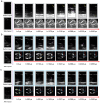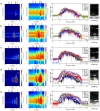Simultaneous High-Frame-Rate Acoustic Plane-Wave and Optical Imaging of Intracranial Cavitation in Polyacrylamide Brain Phantoms during Blunt Force Impact
- PMID: 38391618
- PMCID: PMC11605226
- DOI: 10.3390/bioengineering11020132
Simultaneous High-Frame-Rate Acoustic Plane-Wave and Optical Imaging of Intracranial Cavitation in Polyacrylamide Brain Phantoms during Blunt Force Impact
Abstract
Blunt and blast impacts occur in civilian and military personnel, resulting in traumatic brain injuries necessitating a complete understanding of damage mechanisms and protective equipment design. However, the inability to monitor in vivo brain deformation and potential harmful cavitation events during collisions limits the investigation of injury mechanisms. To study the cavitation potential, we developed a full-scale human head phantom with features that allow a direct optical and acoustic observation at high frame rates during blunt impacts. The phantom consists of a transparent polyacrylamide material sealed with fluid in a 3D-printed skull where windows are integrated for data acquisition. The model has similar mechanical properties to brain tissue and includes simplified yet key anatomical features. Optical imaging indicated reproducible cavitation events above a threshold impact energy and localized cavitation to the fluid of the central sulcus, which appeared as high-intensity regions in acoustic images. An acoustic spectral analysis detected cavitation as harmonic and broadband signals that were mapped onto a reconstructed acoustic frame. Small bubbles trapped during phantom fabrication resulted in cavitation artifacts, which remain the largest challenge of the study. Ultimately, acoustic imaging demonstrated the potential to be a stand-alone tool, allowing observations at depth, where optical techniques are limited.
Keywords: cavitation; cranial phantoms; plane-wave imaging; polyacrylamide; shockwaves; traumatic brain injury (TBI).
Conflict of interest statement
The authors declare no conflicts of interest.
Figures








Similar articles
-
Sulcal Cavitation in Linear Head Acceleration: Possible Correlation With Chronic Traumatic Encephalopathy.Front Neurol. 2022 Feb 28;13:832370. doi: 10.3389/fneur.2022.832370. eCollection 2022. Front Neurol. 2022. PMID: 35295830 Free PMC article.
-
Investigation of cavitation as a possible damage mechanism in blast-induced traumatic brain injury.J Neurotrauma. 2012 Jul 1;29(10):1970-81. doi: 10.1089/neu.2011.2224. Epub 2012 May 14. J Neurotrauma. 2012. PMID: 22489674
-
Using Wavelet Analysis to Distinguish Cavitation Acoustic Emissions From Blunt Impact Noise.J Biomech Eng. 2021 Jul 6. doi: 10.1115/1.4051660. Online ahead of print. J Biomech Eng. 2021. PMID: 34227649
-
Cavitation in blunt impact traumatic brain injury.Exp Fluids. 2024;65(8):114. doi: 10.1007/s00348-024-03853-6. Epub 2024 Jul 17. Exp Fluids. 2024. PMID: 39036013 Free PMC article. Review.
-
[Mild traumatic brain injury and postconcussive syndrome: a re-emergent questioning].Encephale. 2012 Sep;38(4):329-35. doi: 10.1016/j.encep.2011.07.003. Epub 2011 Aug 31. Encephale. 2012. PMID: 22980474 Review. French.
References
Grants and funding
LinkOut - more resources
Full Text Sources
Research Materials

